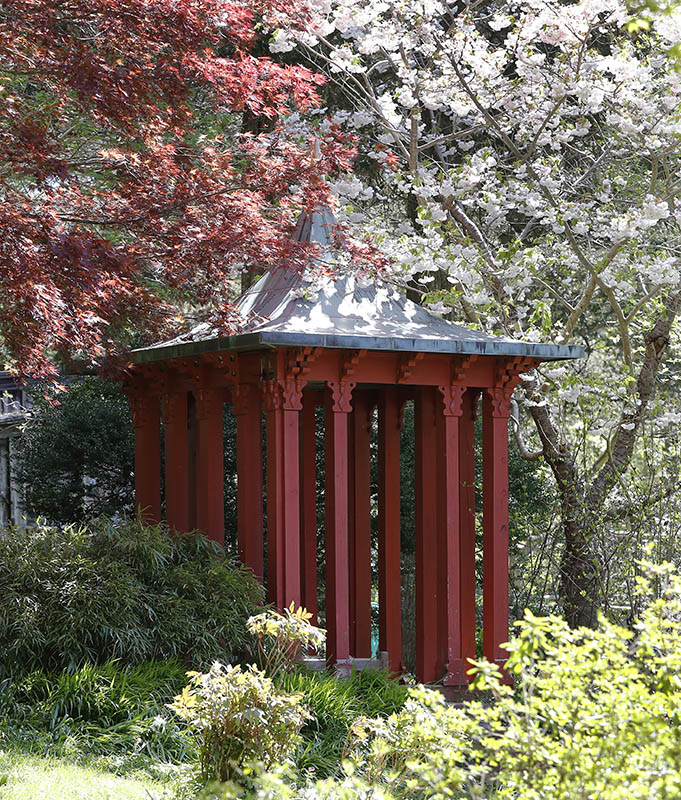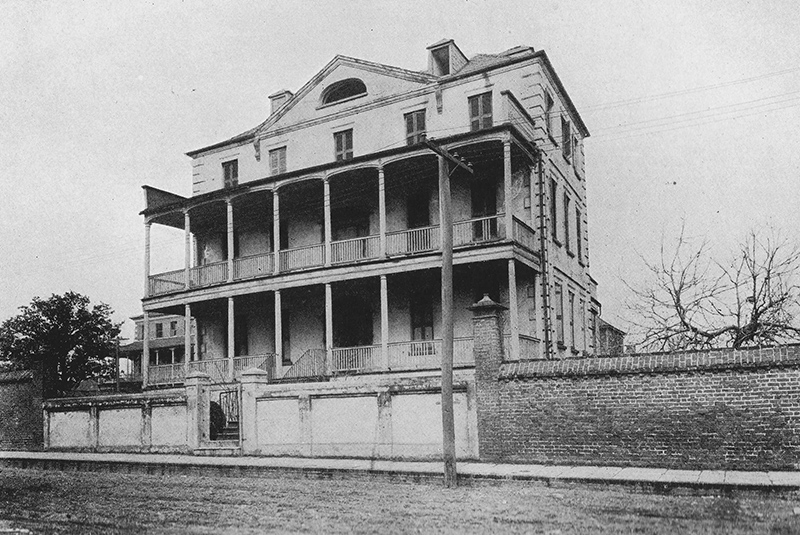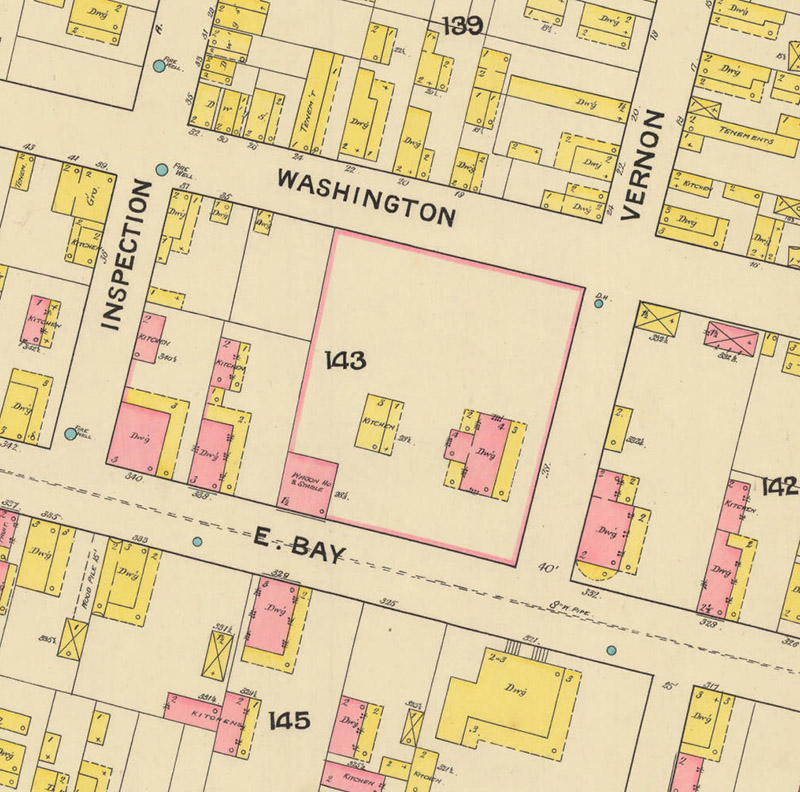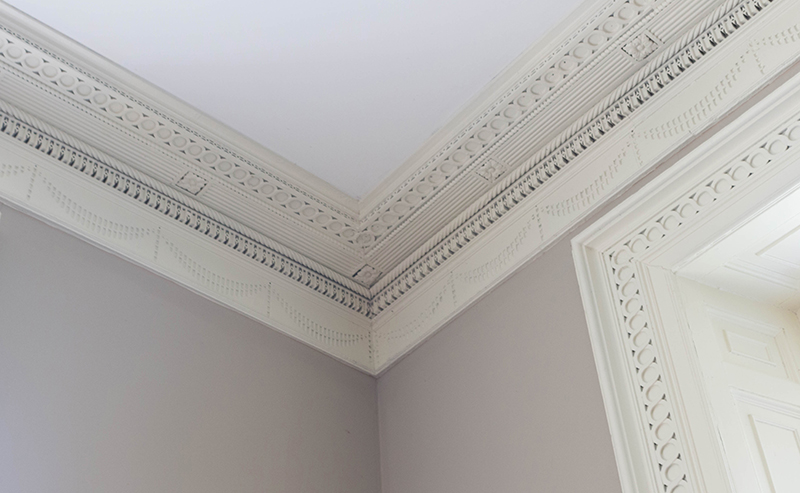Long Hill: 19th-Century Charleston Architecture on Massachusetts’s North Shore
by Christie Jackson
Passing through the front door at Long Hill (figure 1), the early-20th-century residence of the Sedgwick family in Beverly, MA, one is compelled to gaze upward. Ornate cornices, window and door architraves, carved hallway arches, and mantels throughout the house command a presence and hint at a time long before the home’s 1925 construction. The unusual path that these elaborate Federal-period interiors took to ultimately land in Beverly created a breadcrumb trail that has revealed itself over the past year. The story uncovered—of one family’s love of history, of early preservation efforts, and, most importantly, of the untold story of enslaved artisans—has given The Trustees of Reservations a renewed passion to steward these important artifacts for future generations.
Long Hill is a Federal Revival home designed by the Boston firm Richardson, Barott & Richardson for Ellery and Mabel Cabot Sedgwick (figure 2). Ellery was the long-time editor of the Atlantic Monthly and enjoyed celebrity status during his tenure in the 1920s. His first wife, Mabel Cabot Sedgwick, was a well-known horticulturist, writing the much-beloved The Garden Month by Month, which still graces gardeners’ bookshelves today. Wanting to create an oasis on the North Shore of Massachusetts, the Sedgwicks purchased five subdivided lots of land in Beverly to create the 114-acre estate that houses Long Hill.
The Sedgwicks, as was en vogue at the time, were interested in incorporating architectural salvage into their home. Bricks from a hosiery mill in Ipswich, MA, formed much of the façade. Recycled antique doors came from coastal Salem. Panels of 19th-century Chinese export wallpaper from a home in Stratford-upon-Avon were found in the shop of London antique dealer Thornton-Smith, and have received conservation in recent months (figure 3). A Chinese garden house, once belonging to a local sea captain, was brought to Long Hill’s gardens and painted red by Ellery himself (figure 4).
Perhaps influenced by a national trend of interest in period rooms, the Sedgwicks wished to include historical interiors in Long Hill. They soon “came and fell in love” with the Isaac Ball mansion in Charleston, built in 1812 by Isaac and Eliza Ball (figure 5). During the planning process for the house, Mabel Cabot Sedgwick summarized the immensity and uncertainty of the project, recounting “[the house] is still unbuilt, although plans and inside finish stand waiting. Who knows whether the old southern house whose interior is stored in our barn, will ever get to itself another shell and live again. World war and chaos have stepped in to change its history and ours.”1 Eventually the woodwork would be used in the home, a feature celebrated in the August 1925 issue of House Beautiful. The article noted the interiors gave Long Hill “the dignity, spaciousness, and hospitality of the old Southern mansions.”
While, on face value, this appears to be a fashionable design choice for the Sedgwicks, recent scholarship has revealed that their decision to incorporate these interiors was deeply rooted in a desire to preserve both history and connections to Charleston. The Sedgwicks were friendly with Charleston preservationist Susan Pringle Frost, even staying at her home on occasion, which made the local newspapers. Frost brought a lot of firsts to Charleston: she was one of the first women to own a business in the city and one of the first to drive a car.2 She also founded the Society for the Preservation of Old Dwellings (today, the Preservation Society of Charleston) and helped bring about the city’s first preservation restrictions.
During one of the Sedgwicks’ trips to the city, Frost helped connect them to the Isaac Ball mansion. At the time of its completion, the estimated cost of the six-lot parcel and house on Vernon Street was a stunning $20,000 (figure 6). Extensive family correspondence and building records survive, giving a rare paper trail for the completion of the building. The house survived the Civil War as well as Charleston’s earthquake of 1886 largely unscathed. By the time the Sedgwicks visited in 1916, however, the property had fallen into disrepair, most recently used as a cigar factory.
A family account summarized the first time Frost and the Sedgwicks saw the property together, which was owned by the Norfolk and Virginia Railway and was about to be used as a rooming house for workers. The house was in derelict condition, and Mr. Sedgwick tracked down the railroad president and “explained that a valuable work of Charleston antiquity was about to be destroyed, and that the owner would be to blame. The president admitted that he understood the situation since his wife was interested in antiques, and suggested that Mr. Sedgwick…submit a typewritten proposal…offering to replace the carved woodwork of five rooms in plain deal. The work was carried out by Pinckney, a clever black carpenter, who took down and numbered the woodwork, which was shipped in a schooner…The cost of replacement was six hundred dollars.”3
Ultimately, the mansion’s interiors would become the focal point of Long Hill. In a 1922 letter by Ellery Sedgwick to Charleston preservationist Albert Simons, Sedgwick wrote “…now am I preparing to install [the interiors] in the house which I am building for the purpose at Beverly, Massachusetts.” The choice of phrasing “for the purpose” emphasizes the woodwork’s importance to the home’s design (figure 7). Recent paint analysis further supports this conclusion: matching, intact paint stratigraphy within each Long Hill room suggests that these spaces conform to the size of their Charleston counterparts. This strategy allowed each interior to be used intact.
The installation only tells half the story. Recent research into the construction of the Ball house has revealed an incredibly important history imbued in the woodwork now at Long Hill. The use of enslaved carpenters to help build up Charleston’s elite homes is an increasingly told story, and the Ball family was no stranger to this practice. The Balls owned 12 Lowcountry plantations, including Comingtee and Limerick, and over 1,300 slaves.4 Surviving plantation records note the presence of at least 20 enslaved carpenters. Their highly skilled work is mentioned in various accounts and records, as in this 1904 remembrance: “The carpenters could not only construct the flood-gates and rice-field trucks, and build the [slave] houses, but make the plantation wagons and cars, and do work, requiring great neatness of finish. Very credible pieces of furniture were sometimes made by them. The wooden addition to the dwelling house [at Comingtee] was built and completed, inside and out, by these plantation carpenters;—even as I have heard to the window-sashes.”5
The enslaved carpenters moved between the Ball properties, including the Isaac Ball mansion, to make use of their specialized skills, a common practice at the time.6 A carpenter’s book records the various tools the enslaved artisans used for their work in Charleston, including ogee planes, sash plains, astragal plains, and a set of chisels—tools that only skilled carpenters would use. These artisans were seldom mentioned in past scholarship about the Isaac Ball mansion, but today we have new insights into their work that allows us to acknowledge them by name.
Woven into the building records for the Isaac Ball mansion are invoices for work by builder James Dupre, carpenter/builder John George Spindle, turner John Whiting, and cabinetmaker Thomas Wallace telling one narrative of construction by white craftsmen. However, we have uncovered references to the work of the enslaved carpenters named Marcus, Plenty, Lit[tle] Marcus, Lit[tle] Pompey, Billy, Drummer, Fortune, Jeffrey, Guy, and Daniel, which tell a more complete story of the mansion’s fabric and fabrication (Figures 8 and 9). Their voices, silent for so long, can now be celebrated.
The interiors of the Isaac Ball mansion now at Long Hill embody a remarkable story of enslaved craftsmanship. History evolves, as does our understanding of it. Today, we look with new vigor at the woodwork at Long Hill. Long admired for the beauty it brought to the Sedgwicks’ home, we can also celebrate the artistry and complexity behind its creation.
1 Mabel Cabot Sedgwick. “Long Hill,” unpublished lecture dated September 8th, 1920.
2 Sidney Bland. Preserving Charleston’s Past, Shaping Its Future: The Life and Times of Susan Pringle Frost (Columbia: University of South Carolina Press, 1999), 55-57.
3 Marjorie Russell Sedgwick. “The Master List of Plants at Long Hill, Beverly, Massachusetts, 1977,” unpublished manuscript.
4 Lorri Glover, “An Education in Southern Masculinity: The Ball Family of South Carolina in the New Republic,” The Journal of Southern History, Vol. 69, No. 1 (February 2003): 70.
5 Anne Simons Deas. Recollections of the Ball family of South Carolina and the Comingtee Plantation. 1909. 161.
6 Mary Allison Carll-White, “The Role of the Black Artisan in the Building Trades and the Decorative Arts in South Carolina’s Charleston District, 1760-1800,” University of Tennessee, 1982. 49.
Christie Jackson is the Senior Curator for The Trustees of Reservations (TTOR). Long Hill was given to TTOR in 1979. For a time, the house was used as a headquarters for TTOR, which owns 119 properties of cultural, historical, and ecological importance throughout Massachusetts. Today, the property is going through a renaissance thanks to an anonymous grant to rejuvenate the gardens and house.
A print version of this article was published in The Magazine of the Decorative Arts Trust, one of our most popular member benefits. Join today!









